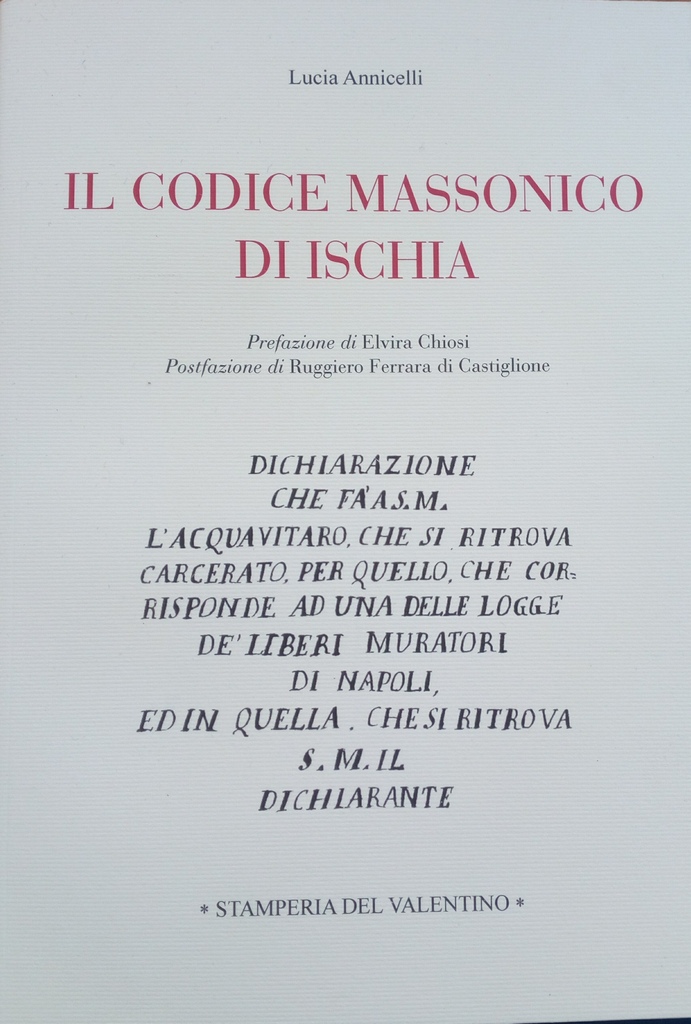After centuries of oblivion, the Masonic Code of Ischia tells its story

In these days it is exposed at the entrance to the conference hall. Well visible to anyone who enters, on the side opposite the plaster bust of Monsignor Onofrio Buonocore, founder of the Antoniana Library from whose windows you can admire the Aragonese Castle and penetrates the salty air of the nearby sea. The paper strongly yellowed by time, with large signs of humidity, indicates its most evident value in the past. But it is not for this reason that the book with the blue cover has won so much visibility, until it became the protagonist of another book, just published by Lucia Annicelli, director of the Library: “Il codice massonico di Ischia”. The fruit of ten years working around those yellowed pages, swallowed for decades by the darkness in one of the Antoniana’s walnut cabinets.
To identify the blue volume, the BCA 450 card, which linked it to the list of manuscripts.
A sea in which, in the summer of 2007, young scholar Lucia Annicelli began to discover, just arrived in the municipal library. In looking for the works that belonged to Buonocore, it had happened in her hands that book, strangely untitled and with the sole name of the author on the back: Lucrezio Caro. It was a copy of the translation by Alessandro Marchetti of “De rerum natura” by Lucrezio in “Florentine volgare”. Then, added in pencil by Buonocore, the phrase “Following the Statute of Freemasonry”, with two question marks.
“Already the indications on the work of Lucrezio had intrigued me - says Lucia Annicelli - but looking closely at the book, I noticed immediately that the last pages protruded from the others.
In fact, it was an addition to the “De rerum”, separate from the binding. On the front page appeared numerous symbols unknown to me, with a legend below in which the words “grand master” struck me. Recalling the note of Buonocore, I understood that the writing concerned Freemasonry. I continued to leaf through it, finding that the title page on the cover page had been linked to the opposite: why? In the title, there was talk of the declaration of a distiller, about one of the lodges of “free bricklayers of Naples”, but there was no date. At that point, it was clear that it was a code remained hidden in the “De rerum” until then. A latomic code to decipher”.
What did that first reading of a completely unexpected text reveal to you?
“In those 25 pages, which I managed to read fluently more and more curiously, I found the Statute with the initiation rite and the Catechism “in the manner of Naples”. Then I arrived at the “Ristretto”, or the chronicle of the formation in Naples of the congregation of masons. Followed the text of the petition to Benedict XIV of Raimondo di Sangro, Prince of Sansevero, in Latin, and the private response of Pope communicated by the Apostolic Nuncio to Naples. It was an extraordinary document, which had taken me a lot on the narrative level. I still remember the feeling I felt in putting it away: there was something to deepen and to defend”.
After that first examination and considering the double identity of that volume, how did it go on?
“I began to document the translation of Marchetti, object of censure so much to be published only in 1717, which then is also the year that marks the evolution from operational Freemasonry to speculative. Just in Naples, Marchetti was considered the inspiration of the atheists, subjected to a process that caused a sensation, connected to the transition from Academic to the Free-masonry. At first I thought about working on both texts, but then I decided to focus on the code”.
So many puzzles to solve, which ones first?
“In the text I found the answer to identify the distiller with the founder of the first “speculative” lodge in Naples, Louis Larnage, a merchant of Lyon. According to the events told, I was able to date the documents up to 1751. I then dedicated myself to the reconstruction of the historical context, through the study of various sources in the Neapolitan archives, but also in our library. The code offers lots of research ideas. It took time to follow them and to document me about Freemasonry”.
What is the contribution of the Ischia code to the knowledge of that historical phase?
“It is a precious document to reconstruct the dawn of speculative Freemasonry in Naples with the Larnage lodge, to which foreign and military bourgeois also joined, in relation to the pre-existing Perfect Union lodge, of English rite and formed by members of the aristocracy cultured, of which was great master Raimondo di Sangro. The symbols turned upside down in the “Quadro di Loggia” of the code, the only joint up to us, summarize that change. The correspondence contained inconvenient truths and for this reason, it was hidden.
It is strongly symbolic that to protect it was the “De rerum”, to which the Neapolitan Masonic tradition referred, so that a verse was inscribed in the seal of the “Perfect Union”.
Did you understand how the code came to Ischia?
“Ischia was frequented by prominent figures of Freemasonry, both Italians and foreigners traveling for the Grand Tour. Many of them were guests of court doctor Francesco Buonocore, an Ischian, in whose library two copies of the “De rerum” were featured. Some important documents and family books came into the hands of Monsignor Onofrio Buonocore from a Neapolitan aunt and it is plausible that there were also the manuscript of the “De rerum” and its particular hidden appendix… still to be studied.









